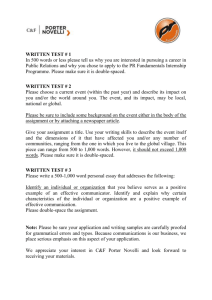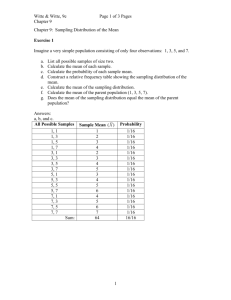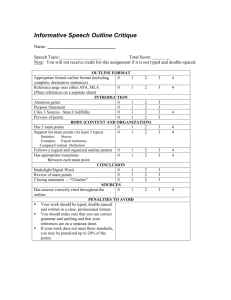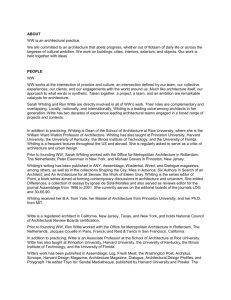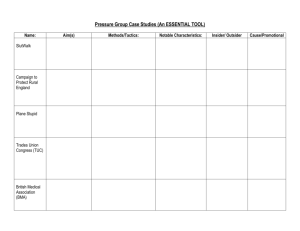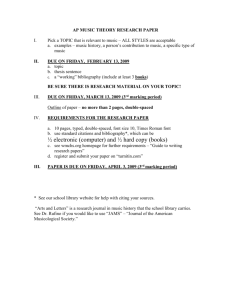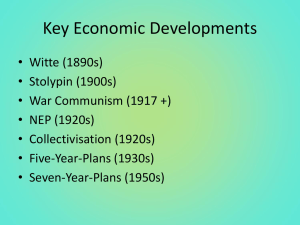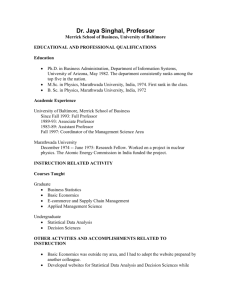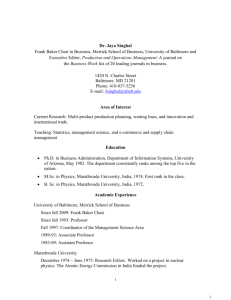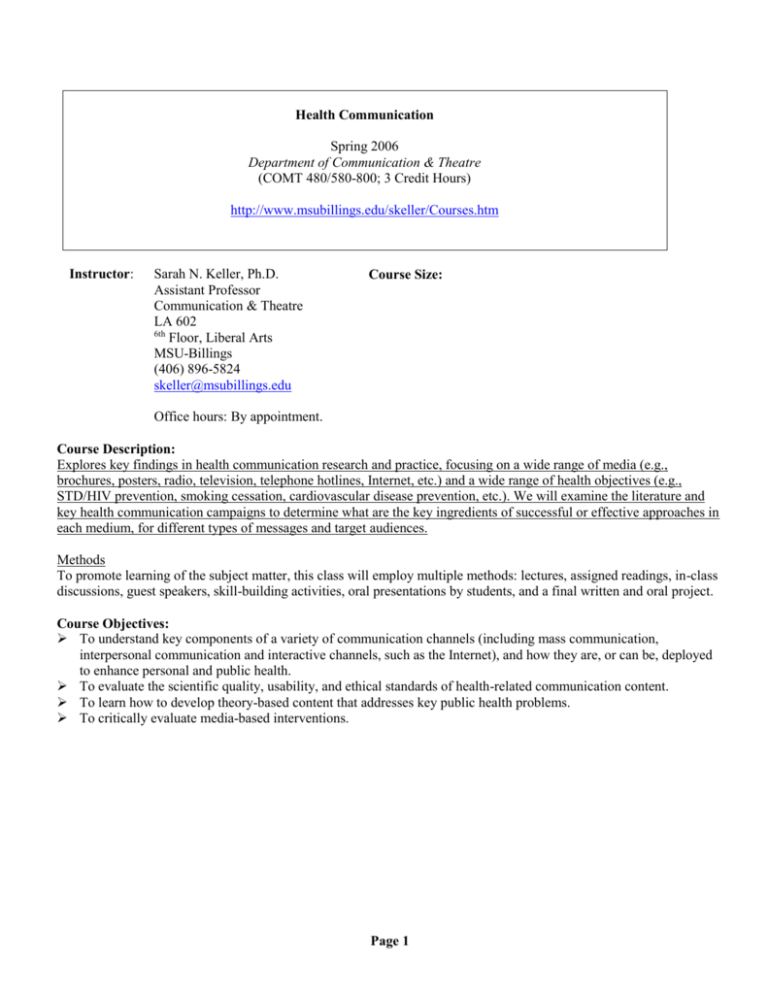
Health Communication
Spring 2006
Department of Communication & Theatre
(COMT 480/580-800; 3 Credit Hours)
http://www.msubillings.edu/skeller/Courses.htm
Instructor:
Sarah N. Keller, Ph.D.
Assistant Professor
Communication & Theatre
LA 602
6th
Floor, Liberal Arts
MSU-Billings
(406) 896-5824
skeller@msubillings.edu
Course Size:
Office hours: By appointment.
Course Description:
Explores key findings in health communication research and practice, focusing on a wide range of media (e.g.,
brochures, posters, radio, television, telephone hotlines, Internet, etc.) and a wide range of health objectives (e.g.,
STD/HIV prevention, smoking cessation, cardiovascular disease prevention, etc.). We will examine the literature and
key health communication campaigns to determine what are the key ingredients of successful or effective approaches in
each medium, for different types of messages and target audiences.
Methods
To promote learning of the subject matter, this class will employ multiple methods: lectures, assigned readings, in-class
discussions, guest speakers, skill-building activities, oral presentations by students, and a final written and oral project.
Course Objectives:
To understand key components of a variety of communication channels (including mass communication,
interpersonal communication and interactive channels, such as the Internet), and how they are, or can be, deployed
to enhance personal and public health.
To evaluate the scientific quality, usability, and ethical standards of health-related communication content.
To learn how to develop theory-based content that addresses key public health problems.
To critically evaluate media-based interventions.
Page 1
Course Calendar:
Date
1/18
Topic
Overview of health
communication
1/23
1/25
1/30
Details
OVERVIEW LECTURE
Lessons learned from past health communication campaigns
Examples of successful campaigns (presentation)
Health
communication
theory
THEORY-BASED EDUCATION
Theories of health behavior change (overview)
Witte, ch. 1
Developing a high
quality and usable
health message
/campaign
Entertainment
Education
Fear appeals
Witte, ch. 2
International social marketing efforts using TV, video, music, and
theatre to promote health objectives
History of entertainment education campaigns overseas to promote
family planning, maternal & child health, and other social
development goals
Discussion of domestic efforts to use entertainment programming for
educational messages, including embedded messages in sit-coms
Singhal & Rogers, ch. 1
(handout)
Simplemente Maria
Singhal & Rogers, ch. 2
(handout)
Theorizing from our everyday health practices
Narrating life & health
Health beyond medicine
Geist-Martin, ch. 1
Narrating personal, cultural and political complexities
Narratives of health and illness
Narration & identity
Multicultural health & illness communities
AIDS as a case study
Cultural sensitivity
Extended Parallel Process Model
Witte, 4
Witte, 5
Other Health Education Theories
Formative Research (e.g., literature review, baseline survey,
selecting key messages, channels, target audience, etc.)
Message tailoring & pre-testing
Risk Behavior Diagnosis
Witte, 6
Data Analysis
Dissemination
TBA
Overcoming digital, economic and cultural barriers
Resources (to compete with/lobby for changes in mainstream media
content)
Controversial issues (e.g., sexual health)
Bridging knowledge to action gap
Working with communities (need to build ground-level support)
Witte, 9
Witte, 10
Singhal & Rogers
Geist-Martin, ch. 11
Assignment due:
Exercise 1.3
2/1
2/6
2/8
2/13
2/15
2/20
2/22
2/27
3/1
3/3
3/13
3/15
History of
Entertainment
Education
Communicating
Health
Personal
Complexities of
Health & Illness
Health in Multicultural Communities
Mass Media
Campaigns
Long-term
effectiveness
Persuasive
Information
Effectiveness
Key issues
Page 2
Assignments Due
Begin Assignment:
Exercise 1.3
Geist-Martin, ch. 2
Geist-Martin, ch. 3
Assignment due:
Exercises 3.1 & 3.2
Witte, 3
3/20
3/22
Patient-provider
communication
Internet health
Navigating Health Care Organizations
Geist-Martin, ch. 10
INTERNET HEALTH COMMUNICATION
How to evaluate Internet health interventions
Review of major Internet interventions
Online Support groups
Tailoring content
How to incorporate theory into Web site design Illness-related
communities
Outcomes of Internet health interventions that have been evaluated
Managing relationships
End of life health
Meta-Analysis of U.S. Health Campaigns
Rice & Katz,
ch. 1**handout
Presentations of class projects
Final projects due
3/27
3/29
4/3
Ethics
Effectiveness
4/5
Presentations
4/10
Last Day
Geist-Martin, ch. 7-8
Singhal & Rogers
Media piece of the week (30%)
Students will volunteer once over the semester (must be before April) to give a paper and presentation describing a
health message. Sign up with me early in the semester for a time to present your media piece – and that will
determine your due date:
Presentation:
A 10-minute oral presentation on a health communication example of their choice (e.g., Web
site, public service announcement, brochure, etc.). They will describe why they chose the piece and then take the
class on a “tour” of their material. They should describe the approach (including what theoretical strategies may be
employed), the message (i.e., expected health outcome), target audience, dissemination plan, and any evaluation
strategies employed (the latter may require communication with the message source). Throughout the presentation,
students should suggest areas for improvement and evaluate its scientific quality, usability and compliance with
ethical standards.
Paper:
Students should also turn in a 4-page summary (double-spaced) of their presentation. For the paper,
ample use of external resources (i.e., journal articles, books, newspaper articles, etc.) is expected to describe the
context for the message, the health problem it addresses, and other similar interventions that have succeeded or
failed.
Journal Theory Practice 1.3 (not graded)
Keep a journal that you enter into once per week for 1 month. Describe one health behavior that you engaged in that
week that is either healthy or unhealthy. Explain why you did or do this behavior, and how you believe it contributes or
detracts from your health. Be honest! Describe how communication was part of engaging in this behavior; for example,
did something your friends say or do influence you? Describe how you might ensure continuing this healthy behavior or
reducing and eliminating the unhealthy behavior. Mention any obstacles that you foresee. Prepare to let other students in
the class read your journal. We will treat any material that we read in each others’ journals as confidential (i.e., we will
not talk about it with anyone outside of the class).
Multicultural Theory Practice 3.1 (20%)
Write a 2-4-page mini-paper that explains your health beliefs and how they are connected to your sub-cultural
community. Tell about the ethnic, cultural, or subcultural group that you most identify with. How do you define health,
and does this differ from the views of your friends, spouse, parents, grandparents? If so, how? What factors does your
cultural group believe cause illness? How are common illnesses treated? What are some practices used to prevent illness
Page 3
within your cultural group? Who do people in your group consult with when they are ill? Use external resources
wherever possible to back up what you say.
Final Class Project (30%)
Students will prepare both a written and an oral version of one of the following projects (Conduct a literature review to
demonstrate your knowledge of the subject: Place your health issue in its context! All final projects must use at least 4
external references; more is better):
(1) Develop a health-related Web site of your own (must have a specific attitudinal or behavioral health objective, use
a theory-informed design, and include evaluation and dissemination strategies). Web site must be accompanied by a
10-15-page, double-spaced paper that explains objective, method of design, theory, and evaluation plan.
(2) Conduct a content analysis study on health-related content for a specific medium, focusing on a particular health
topic (e.g., rating Internet Web sites about STD/HIV, content analysis of sexual health messages on prime-time TV
show(s), etc.). Content analysis must be accompanied by a 10-15-page, double-spaced paper that explains the
objective, method, sampling strategy, results, and implications of your study. See me for a tutorial on content
analysis.
(3) Conduct an evaluation of an existing educational health message or campaign (may be the message you chose
for your Media Piece of the Week. You will collect primary data (e.g., focus groups to test reactions to a PSA or
Web site, experimental design to test impact of a message, pre-post test using written questionnaires). Evaluation
data must be analyzed; both procedure and results must be written up in a 10-15-page, double-spaced report.
If none of these options are appealing, you can propose an alternative to the instructor.
Page 4
Texts and Other Materials:
Both of the following may be obtained from Beezer’s. Any supplementary materials will be handed out in class.
Geist-Martin, P., Ray, E.B., Sharf, B.F. (2003). Communicating Health: Personal, Cultural and Political Complexities.
Canada: Thomson Learning. Required.
Kim Witte, Gary Meyer, Dennis Martell (2001). Effective Health Risk Messages. Newbury Park: Sage Press. Required
Singhal, A., & Rogers, E.M. (1999). Entertainment-education: A Communication Strategy for Social Change. Mahwah,
NJ: Lawrence Erlbaum Associates. Recommended.
Maibach, E., Parrott, R.L. (1995). Designing Health Messages: Approaches from Communication Theory and Public
Health Practice. Thousand Oaks, Calif.: Sage Publications, c1995. Recommended.
Course Grading:
All assignments must be produced on a word processor or typed double-spaced. Spelling, grammar and appearance
count. Assignments are due at the beginning of each class as specified in the course schedule. Work handed in late will
receive one letter grade lower than its quality merits, and will not be accepted more than one week after it is due.
Media piece of the week:
Multicultural piece:
Class participation:
Final project:
30%
20%
20%
30%
Note to Students:
If you believe you have a disability that may warrant accommodations in this class, I urge you to register with Trudy
Carey, the disability services coordinator, in Rm. 10 of the Academic Support Center, 657-2283.
Page 5

